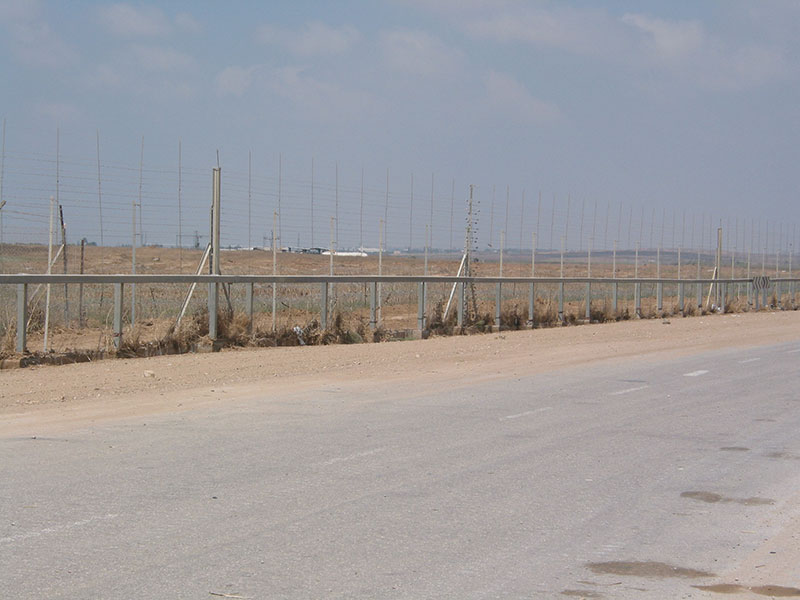The Blurred Distinction Between Armed Conflict and Civil Unrest: Recent Events in Gaza
On April 6, for the third weekend in a row, Palestinians residents of Gaza confronted the Israeli Defense Forces near the fence separating the Gaza Strip from Israel. According to Palestinian sources, overall more than 30 Palestinians have died and hundreds have been wounded, since the beginning of the clashes.

Published by The Lawfare Institute
in Cooperation With

On April 6, for the third weekend in a row, Palestinians residents of Gaza confronted the Israeli Defense Forces near the fence separating the Gaza Strip from Israel. According to Palestinian sources, overall more than 30 Palestinians have died and hundreds have been wounded, since the beginning of the clashes. (For an overview of the events from a source with strong connections to Israeli intelligence, see here.) Israeli sources claim that most casualties were men between the ages of 18 and 45 who were known Hamas operatives.
During the confrontations, the IDF has used less-lethal weapons and crowd control measures, such as tear gas and water cannons, but also live fire. According to some reports, after warning shots were fired, snipers near the fence shot live fire at people who had crossed the first fence and were headed to the second, main security fence.
Did the IDF act appropriately and lawfully under international law? Answering this question requires addressing which legal framework governs the conflict along the Gaza border. And to do this, we must understand the state of affairs between Israel and the Gaza Strip over the last ten years.
In the summer of 2005, Israel implemented its disengagement plan from the Gaza Strip, evacuating its civilian settlements in the area and withdrawing its military forces to the pre- 1967 lines set before Israeli forces captured the area from Egypt. Two years later, Hamas gained control over the territory in a coup d’état directed against the Palestinian Authority—led by the Palestinian Liberation Organization—which was established by the Oslo Accord. Since 2007, Israel has considered the Gaza Strip to be territory controlled by a hostile terrorist entity and has tightened its control over the movement of people and goods to and from the territory. Israel's position, approved by the Israeli Supreme Court, is that due to the lack of effective control on the ground, it is no longer the occupying power over Gaza as defined in International Humanitarian Law. Others have taken the view that the continued Israeli control over Gaza's airspace, maritime area, and most of the land crossings (Egypt controls the eastern border of the Gaza strip and the Rafah crossing) creates at least some residual obligations under the law of belligerent occupation.
In the last ten years since Hamas gained power, three major rounds of military escalation have taken place—in 2009, 2012 and 2014. These clashes involved rocket fire from Gaza against Israeli population centers and Israeli airstrikes within the Gaza Strip, along with temporary land incursions by the Israeli military into Gaza, raids by Hamas operatives across the fence through underground tunnels, and improvised explosive devices (IEDs) laid by Hamas on and near the fence in order to target Israeli military patrols. Apart from these major rounds of violence, armed incidents between the parties continue sporadically. For instance, in February this year, four IDF soldiers on patrol were wounded by a hidden IED when they stopped to remove a flag placed on the fence in earlier demonstrations. Later, the IDF attacked Hamas targets in Gaza and a rocket shot from Gaza hit a house in southern Israel.
Against this backdrop, what is the applicable legal framework? It seems to me that the continuous violence in and around the Gaza Strip supports the position that there is an ongoing armed conflict between Israel and the Hamas and other Palestinian armed organizations in Gaza. Whether this conflict should be classified as an international armed conflict or a non-international armed conflict is less important in the present context.
With respect to the rules of engagement governing the measures applied by Israel to stop crossing of the border fence, the situation is more complicated. The public discourse in Israel tends to oscillate in this regard between two opposing poles: According to some, lethal force may be used against any person attempting to cross the fence from Gaza to Israel because Israel has a right to defend its sovereignty and because of the existing cross-border terror threats. The opposite view stipulates that a violent demonstration by civilians in Gaza should be treated like any other demonstration, even if it threatens to destroy parts of the security fence between Israel and a terrorist entity in a conflict area, and even if there is a genuine concern that terror attacks will be launched from amidst the demonstrators. Under this law enforcement paradigm, lethal force may be used only against a person causing imminent risk for the life of others—for instance, toward an armed person located in the midst of the demonstrators who is about to shoot soldiers on the other side of the border.
I am of the view that both opposing positions present an inaccurate description of the legal and factual reality. To be clear, the use of indiscriminate fire against civilians, even if they cross a border or sabotage a military installation, is absolutely prohibited. Still, the view that military forces defending the border should remain idle because the risk to lives is not imminent—even after the exhaustion of less-lethal means and amid the destruction of the border fence by a mob—is too strict and narrow an interpretation of international humanitarian law.
The purpose of IHL is to strike a balance between military necessity and humanitarian concerns during an armed conflict. Rules that ignore legitimate military needs are not likely to be sustainable. Moreover, a significant breach of the border fence could be exploited for planting IEDs or for entrance into Israel of terror squads or a violent mob aiming to attack Israeli civilians. Such developments present a grave and concrete danger to life, even if not imminent in nature.
In an extreme scenario, rioting civilians—even unarmed—can be considered as directly participating in hostilities provided that they perform acts of violence which are specifically designed to support their side of the conflict and harm the enemy state. Such acts of violence may include destruction of military equipment or diverting attention of the armed forces to support an attack occurring in another place. In fact, this opinion was expressed in an expert meeting convened by the International Committee of the Red Cross in 2012 on the use of force in armed conflict and the interplay between the conduct of hostilities and law enforcement paradigm. (See page 26 of the report.)
Note, however, that this was not the mainstream opinion of the experts present in the meeting. For that reason, as well as for practical and policy considerations, the defending military in extreme situations involving violent civilians should focus its use of force on people who appear to lead and instigate the rioters. Even then, the military should use the minimum amount of force needed to stop the harmful act.
This question of limits on the use of force may be decided by the courts. Four Israeli human-rights organizations have appealed the Supreme Court to order the IDF to revoke any regulation that allows soldiers to use live fire against demonstrators at the Gaza border who do not pose a substantial and immediate threat to human lives.
Haaretz recently reported that the IDF has decided to launch a probe into the confrontations on the border, which will be carried out by a fact-finding mechanism like the one established after the 2014 Gaza operation, known as Operation Protective Edge. This investigation must address whether extreme situations that might justify the use of lethal force actually occurred along the Israel-Gaza strip line during the recent confrontations, and the burden of proof should lie on the military to justify its actions. The investigation should also address whether the IDF undertook adequate preparations for the events, which did not come as a surprise. Furthermore, the investigation should examine whether Israeli authorities had intelligence supporting the conclusion that terror groups were directing the attempts to cross and destroy the fence with an intent to use the riots as a cover or as diversion to promote terror attacks.
Launching an investigation is not an act of self-righteous hypocrisy or an admission of guilt. Rather, it is a necessary component of the rule of law. Moreover, a prompt and effective investigation will allow the IDF to draw lessons and apply them in future confrontations, including by adjusting its regulations or deployment measures. If the investigation uncovers crimes, adjudicating that wrongdoing through the Israeli justice system is preferable to subjecting the perpetrators to international criminal proceedings—which are a method of last resort, resorted to when a state is unwilling or unable to meet its primary responsibility.
The Israeli military should be competent to carry out the investigation itself: the Turkel Public Commission of Inquiry, convened after the 2010 Turkish flotilla incident, asserted that the Israeli military law-enforcement system is generally compatible with international legal standards for independent and effective investigations. Still, the Israeli state comptroller published a report in March noting some flaws in the efficiency and expediency of the fact finding mechanism. Hopefully, the IDF has learned the necessary lessons from this report.




